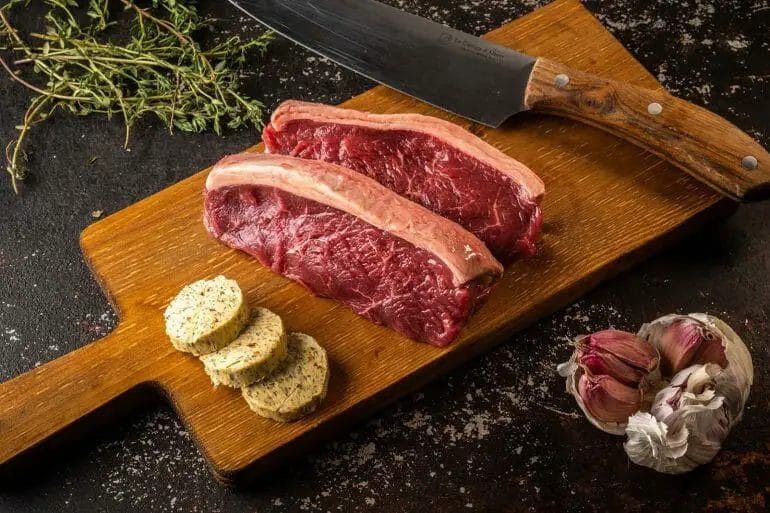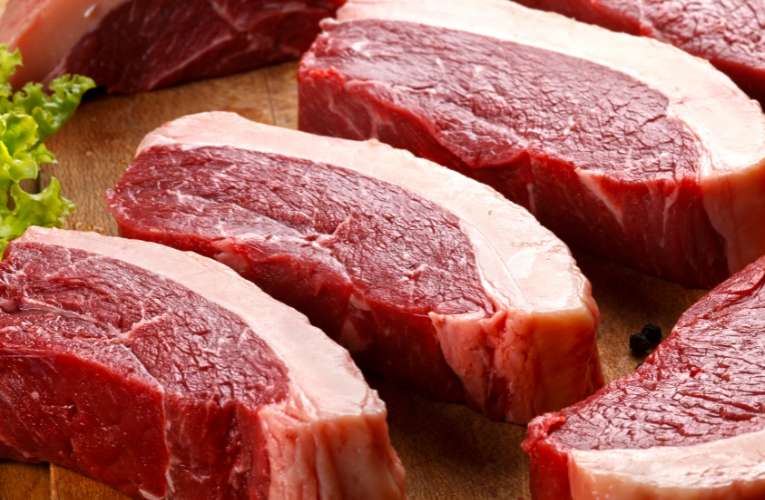Picanha steak, also known as the rump cap or coulotte, is a popular cut of beef that originates from Brazil. This tender and flavorful cut comes from the top of the rump, where a generous layer of fat helps enhance its taste and juiciness.
Picanha is widely recognized for its unique triangular shape and is often cooked on skewers or grilled to perfection. With its rich marbling and succulent texture, picanha steak is a favorite among meat lovers and a must-try for those seeking a delicious and satisfying dining experience.
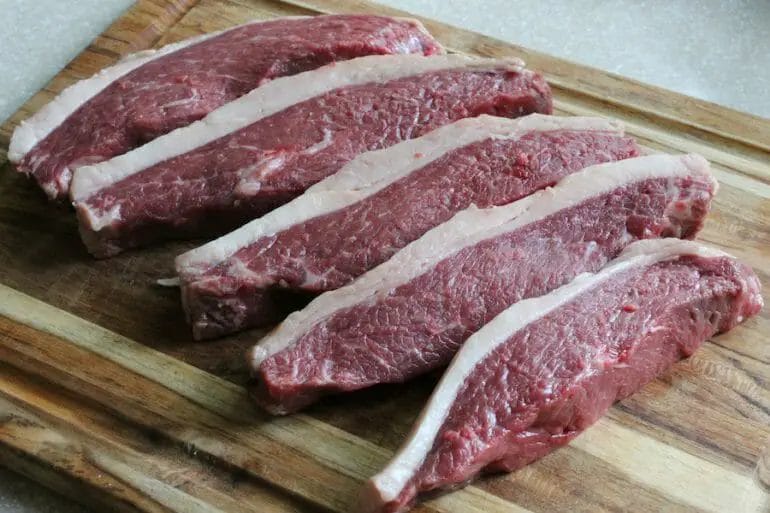
Exploring Picanha: A Flavorful Brazilian Steak
Picanha is a delicious and flavorful Brazilian steak that has gained popularity worldwide for its unique taste and tenderness.
In this section, we will delve into the origins of picanha, its cut, and the different ways it can be prepared to tantalize your taste buds. So, let’s dive right in and explore the world of picanha!
The Origins of Picanha
Picanha, also known as the top sirloin cap or rump cover, originated in Brazil and is a staple in Brazilian cuisine. It is traditionally cooked on a skewer over an open fire, known as churrasco, which is a popular method of cooking in Brazil.
Picanha has been a favorite cut of meat in Brazilian barbecue for centuries and has gained a global reputation for its rich flavor and tender texture.
The Cut of Picanha
Picanha is a triangular cut of beef that comes from the top of the sirloin area, specifically the rump cap. It is a well-marbled piece of meat with a layer of fat on top, which adds to its succulence and flavor.
The fat cap bastes the meat as it cooks, resulting in a juicy and delicious steak that is hard to resist. The unique shape of picanha allows for even cooking and ensures a tender and flavorful piece of meat.
Preparation and Cooking Techniques
Picanha can be prepared and cooked in various ways, each bringing out different flavors and textures. Here are a few popular methods to prepare and cook picanha:
- Rodizio-style: In Brazil, picanha is commonly cooked rodizio-style, on a skewer over an open flame. It is seasoned with coarse salt and slow-roasted until it reaches the perfect medium-rare doneness. The result is a melt-in-your-mouth steak with a smoky and savory flavor.
- Grilling: Picanha can also be grilled on a barbecue or grill pan. It is best to season it with salt, pepper, and any other desired spices before grilling. The fat cap should be scored to allow for even rendering of the fat, resulting in a crispy and delicious crust.
- Oven-roasting: Another popular method is oven-roasting, which is great for those who don’t have access to a grill. Picanha is seasoned and placed in a preheated oven until it reaches the desired level of doneness. This method allows for more control over the cooking process and ensures a juicy and tender steak.
Pairing Picanha with Sides and Sauces
Picanha pairs well with a variety of sides and sauces that complement its rich flavor. Traditional Brazilian sides include feijoada (black bean stew), farofa (toasted cassava flour), and vinagrete (a tangy tomato and onion salsa).
Chimichurri, a vibrant herb sauce, is a popular choice to drizzle over picanha, adding a burst of flavor to each bite. Additionally, a simple sprinkle of coarse salt can enhance the natural flavors of the steak.
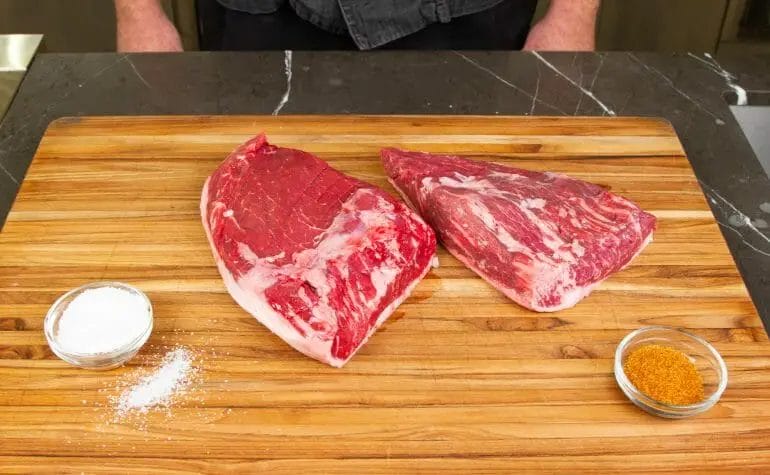
Picanha: The Premium Cut with Unique Flavor
When it comes to indulging in an exceptional dining experience, one cannot overlook the allure of picanha. This premium cut of beef, popular in Brazilian cuisine, offers a unique flavor and tenderness that sets it apart from other cuts.
Whether enjoyed at a high-end restaurant or prepared at home, picanha promises to tantalize taste buds and leave a lasting impression. In this section, we will explore the origins, characteristics, and cooking methods of this exquisite cut.
The Origins of Picanha
Picanha, also known as the top sirloin cap or coulotte, finds its roots in South American culinary traditions, particularly in Brazil. It is a highly sought-after cut due to its excellent marbling and rich flavor.
Originally, picanha was not well-known outside of Brazil, but its reputation has spread across the globe, earning it a place among the finest cuts of beef.
Characteristics of Picanha
What makes picanha truly exceptional is its distinctive characteristics. This cut comes from the top sirloin area of the cow, which is a well-exercised muscle.
As a result, picanha boasts a robust flavor profile and a desirable level of juiciness. The marbling found in this cut adds an extra touch of tenderness, ensuring a melt-in-your-mouth experience.
One defining feature of picanha is the “fat cap” that covers one side of the meat. This fat cap not only enhances the flavor but also acts as a natural basting agent during cooking, keeping the meat moist and succulent.
When cooked properly, the fat cap renders down and becomes crispy, offering a delightful contrast in texture.
Cooking Picanha to Perfection
While picanha may seem intimidating to cook, mastering the art of preparing this cut is well worth the effort. Here are a few popular methods:
- Grilling: Picanha is ideal for grilling due to its fat cap, which helps protect the meat from drying out. Start by seasoning the meat with salt and pepper, then place it on a hot grill. Cook the picanha to medium-rare or medium for the best balance of tenderness and flavor.
- Oven Roasting: Preheat the oven to a high temperature and season the picanha with your choice of herbs and spices. Place the meat in a roasting pan with the fat cap facing up. Roast until the internal temperature reaches your desired level of doneness.
- Sous Vide: For precise and consistent results, consider cooking picanha sous vide. Season the meat and vacuum-seal it in a bag. Submerge the bag in a water bath and cook at a controlled temperature for an extended period. Finish by searing the picanha on a hot skillet or grill.
Enjoying Picanha: Suggested Pairings
To truly savor the flavors of picanha, it is essential to pair it with complementary accompaniments. Here are a few suggestions:
- Chimichurri Sauce: The vibrant flavors of a classic chimichurri sauce, consisting of parsley, garlic, oregano, vinegar, and olive oil, add a refreshing contrast to the richness of picanha.
- Grilled Vegetables: Lightly charred and smoky grilled vegetables, such as bell peppers, zucchini, and onions, provide a delightful balance to the robust flavors of picanha.
- Red Wine: A full-bodied red wine, such as a Malbec or Cabernet Sauvignon, complements the richness of picanha and enhances the overall dining experience.
Understanding Picanha: A Guide to Its Origin and Butchering
Picanha, also known as the sirloin cap or rump cap, is a flavorful and tender cut of beef that has gained popularity in recent years. Originating from Brazil, this cut is a staple in Brazilian churrasco (barbecue) and is loved for its rich flavor and succulent texture.
In this section, we will delve into the origins of picanha and explore the process of butchering this delectable cut.
1. Origin of Picanha
Picanha is a highly prized cut of beef that is derived from the top of the sirloin primal, specifically the cap muscle. It is believed to have originated in Brazil, where it is traditionally prepared and enjoyed as a centerpiece at churrascos.
However, picanha can be found and enjoyed in various parts of the world now, thanks to its growing popularity.
In Brazil, picanha holds a special place in the hearts of meat lovers. It is often considered the crown jewel of any barbecue and is typically seasoned with rock salt, cooked to perfection over an open flame, and served sliced with a side of farofa (toasted cassava flour) and chimichurri sauce.
2. Butchering Picanha
Butchering picanha needs a precise technique to ensure that you get the most out of this flavorful cut. Here’s a step-by-step guide on how to butcher picanha:
- Start with a whole sirloin primal and identify the picanha by its distinct triangular shape, covered with a thick layer of fat.
- Using a sharp knife, carefully trim the excess fat, leaving a thin layer to enhance the flavor and juiciness of the meat.
- Next, locate the natural seams on the picanha and separate it from the surrounding muscles. This will allow for more even cooking.
- Once separated, you can portion the picanha into individual steaks or cook it as a whole roast, depending on your preference.
- Before cooking, season the picanha generously with salt and any additional spices or marinades of your choice.
- Grill the picanha over high heat, fat-side down, to render the fat and develop a flavorful crust. Flip the steak and continue grilling until it reaches your desired level of doneness.
- Allow the cooked picanha to rest for a few minutes before slicing it against the grain to maximize tenderness.
Butchering picanha can be a rewarding experience for meat enthusiasts who enjoy the art of preparing their own cuts. However, if you prefer convenience, you can also find pre-butchered picanha at your local butcher or grocery store.
Cooking Picanha: Tips and Techniques for a Perfectly Grilled Steak
If you are a steak lover, then you must try cooking picanha, a delicious and tender cut of beef that originates from Brazil. Picanha, also known as sirloin cap or rump cover, is a popular choice for grilling due to its rich flavor and juicy texture.
In this section, we will explore some tips and techniques to help you achieve a perfectly grilled picanha steak.
1. Choosing the Right Cut of Picanha
When selecting picanha, look for a well-marbled piece of beef with a thick fat cap. The marbling ensures flavor and tenderness, while the fat cap adds moisture and richness to the steak. Ideally, choose a whole picanha with at least 1.5 to 2 inches of fat cap.
2. Preparing the Picanha
Before grilling, it is important to properly prepare the picanha to enhance its flavor and ensure even cooking. Start by trimming any excess fat, leaving a thin layer to protect and baste the meat during grilling. Score the fat cap with a sharp knife in a crisscross pattern to prevent it from curling up while cooking.
3. Seasoning the Picanha
The key to a delicious picanha steak is a well-balanced seasoning that enhances the natural flavors of the meat. Create a simple seasoning blend using coarse salt, freshly ground black pepper, and any additional spices or herbs of your choice.
Apply the seasoning generously on both sides of the steak, allowing it to penetrate the meat for at least 30 minutes before grilling.
4. Setting up the Grill
For grilling picanha, it is recommended to use a charcoal or gas grill to impart a smoky flavor. Preheat the grill to high heat and ensure that the grates are clean and well-oiled to prevent the steak from sticking.
It is also helpful to have a two-zone fire setup, with one side for direct heat and the other for indirect heat.
5. Grilling the Picanha
Start by placing the picanha, fatty side down, on the direct heat side of the grill. Sear the fat cap for about 5 minutes until it becomes golden brown and crispy. Then, flip the steak and sear the other side for an additional 5 minutes. This initial high-heat sear will help render the fat and create a flavorful crust.
Next, move the picanha to the indirect heat side of the grill and continue cooking until it reaches your desired level of doneness. Use a meat thermometer to check the internal temperature.
For medium-rare, aim for an internal temperature of 130°F (54°C), while medium should be around 140°F (60°C).
6. Resting and Slicing
Once cooked to perfection, remove the picanha from the grill and let it rest for about 10 minutes. Resting allows the juices to redistribute, resulting in a more tender and flavorful steak. After resting, slice the picanha against the grain into thin strips, and serve immediately.
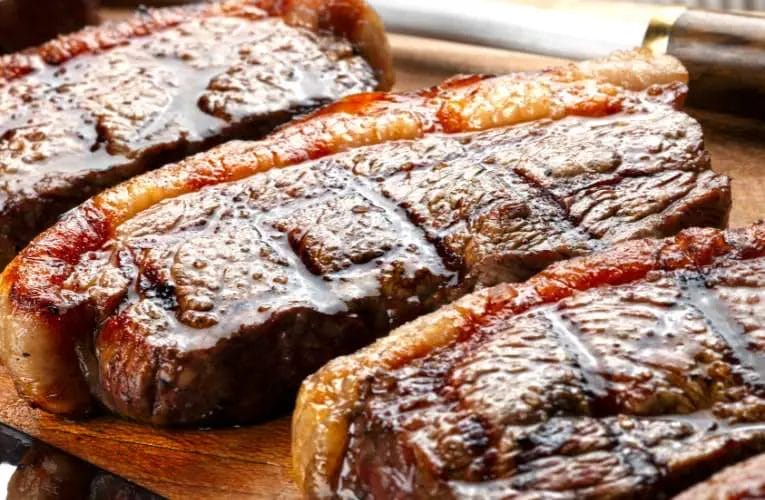
Picanha vs. Other Steaks: Comparing Cuts and Taste
When it comes to steaks, there are numerous cuts to choose from, each offering a unique flavor profile and texture. One such cut that has been gaining popularity in recent years is picanha.
Originating from Brazil, picanha, also known as top sirloin cap or rump cover, has become a favorite among steak enthusiasts. In this section, we will compare picanha to other popular steak cuts and delve into their taste characteristics.
Picanha
Picanha comes from the top sirloin section of the cow and is known for its generous marbling and robust flavor.
It typically has a thick layer of fat on one side, which helps keep the meat juicy and adds a delicious richness when cooked. The fat cap is usually left on during cooking to enhance the flavor and protect the meat from drying out.
When cooked properly, picanha has a tender texture with a slightly chewy bite. The marbling throughout the meat provides excellent flavor and juiciness. Picanha is best cooked medium-rare to medium to ensure a perfect balance between tenderness and taste.
Ribeye
Ribeye, also known as ribeye steak or rib steak, is considered one of the most flavorful cuts of beef. It is obtained from the rib section of the cow and is known for its marbling, which gives it a buttery texture and exceptional taste. The high fat content makes ribeye incredibly tender and juicy when cooked.
The bone-in ribeye, commonly referred to as a cowboy ribeye, adds an extra element of flavor and succulence. This cut is perfect for those who prefer a rich, melt-in-your-mouth experience. Ribeye steaks are best cooked to medium-rare or medium to fully appreciate their tenderness and flavor.
New York Strip
New York strip, also known as strip steak or top loin, is a popular choice for steak lovers. This cut is obtained from the short loin section of the cow and is characterized by its tenderness and bold flavor. Unlike ribeye or picanha, New York strip has less marbling but still offers a satisfying taste.
The texture of New York strip is leaner compared to ribeye or picanha, making it ideal for those who prefer a leaner cut without compromising on flavor. It is often cooked to medium or medium-well to ensure tenderness while preserving its natural juiciness.
T-Bone
The T-bone steak is a combination of two cuts: the tenderloin and the New York strip, separated by a T-shaped bone. This cut offers the best of both worlds, combining the tenderness of the tenderloin and the bold flavor of the New York strip. The T-bone is a favorite among steak enthusiasts.
When cooked properly, the T-bone steak provides a tender, juicy, and flavorful experience. It is often grilled or pan-seared to medium or medium-rare to maintain its tenderness and bring out the rich taste.
Filet Mignon
Filet mignon, also known as tenderloin steak, is highly regarded for its unmatched tenderness. This cut is obtained from the tenderloin section of the cow and is virtually devoid of any fat or connective tissue. Its lean nature makes it a popular choice for those seeking a tender and lean steak.
While filet mignon may lack the bold flavor of ribeye or picanha, it makes up for it with its buttery texture. It is often cooked to medium or medium-rare to maintain its tenderness and prevent it from becoming dry.
Whether you prefer the bold flavors of picanha or the tenderness of filet mignon, exploring the world of different steak cuts is a delightful culinary adventure. Each cut has its own distinct qualities, allowing you to choose the steak that best suits your preference and taste.
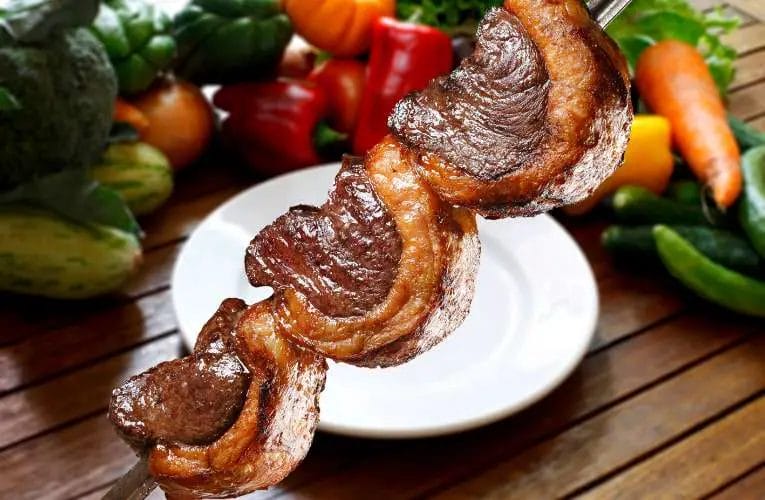
Frequently Asked Questions
1. What cut of steak is picanha?
Picanha is a popular cut of beef in Brazil, also known as top sirloin cap or rump cap. It comes from the top of the rump area and is known for its rich flavor and tenderness.
2. How do I cook picanha?
To cook picanha, it is best to grill or roast it. Start by searing the fat side over high heat to render the fat, then continue cooking it slowly until it reaches your desired level of doneness. Rest the meat before slicing it against the grain for maximum tenderness.
3. Can I substitute picanha with another cut of steak?
If you can’t find picanha, you can substitute it with other cuts such as rump steak, sirloin, or tri-tip. However, keep in mind that the flavor and texture might differ slightly from the authentic picanha.
Conclusion
Picanha is a flavorful and tender cut of beef that originates from South America, particularly Brazil. It is known for its unique triangular shape and generous marbling, which enhances its juicy and succulent texture when cooked.
Picanha is gaining popularity worldwide due to its rich flavor profile and versatility in various cooking methods, such as grilling, roasting, or even pan-searing.
Whether you prefer a melt-in-your-mouth steak or want to impress your guests with an authentic Brazilian churrasco experience, picanha is definitely a cut worth trying. So, fire up the grill and indulge in a mouthwatering picanha steak that will leave you craving for more!
